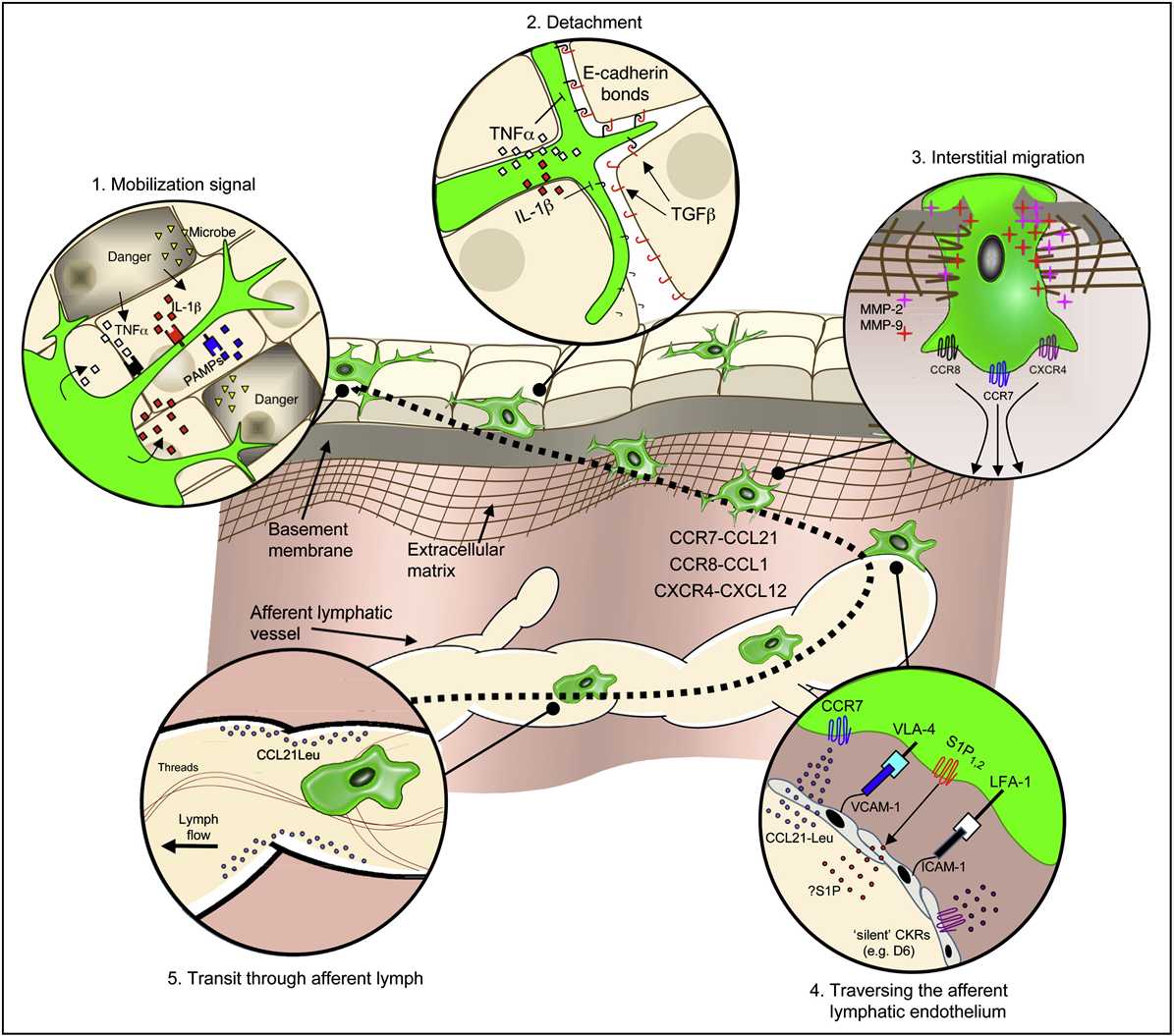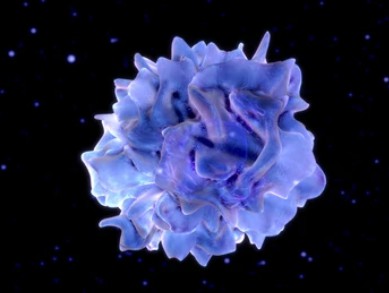Dendritic Cell Adhesion and Migration
Related Symbol Search List
- CD22
- CD147
- CADM1
- CCL21
- CCR7
- CCRL2
- CD209
- CD44
- CD58
- CD83
- CD99
- CD99L2
- CLEC4M
- CMKLR1
- FPR3
- ICAM4
- ITGA4
- LTBR
- L1CAM
- MAG
- MCAM
- CD45
- SPN
Immunology Background
Available Resources for the Study of Dendritic Cell Adhesion and Migration
- Creative BioMart offers a wide range of products related to dendritic cell adhesion and migration-related research, such as recombinant proteins.
- Our team of experts has extensive knowledge and expertise in the field of dendritic cell adhesion and migration. We are committed to providing personalized solutions to meet the specific needs of each researcher.
- To support your research, we offer a comprehensive collection of resources that cover various aspects of dendritic cell adhesion and migration. These resources include detailed information on involved pathways, protein functions, interacting partners, research articles, and others.
Whether you are looking for diverse products, tailored solutions, or scientific resources, Creative BioMart is your one-stop-shop for all your dendritic cell adhesion and migration-related research needs.
Our Featured Products
- Active Recombinant Human CD22 Protein, His-tagged, FITC conjugated
- Recombinant Human CD22, His-tagged
- Recombinant Human CD147, GST-tagged
- Recombinant Human CADM1, His-tagged
- Recombinant Human CCL21, GST-tagged
- Recombinant Human CD209 protein, hFc-tagged
- Recombinant Human CD44, Fc tagged
- Recombinant Human CD44 Protein, hFc-tagged, FITC conjugated
- Recombinant Human CD83 protein, His-tagged
- Recombinant Mouse Cd83 protein, hFc-tagged
- Recombinant Human CD99 protein, Fc-tagged
- Recombinant Mouse Cd99, Fc tagged
- Recombinant Human CLEC4M, Fc tagged
- Recombinant Human ICAM4 protein, His-tagged
- Active Recombinant Human ITGA4 & ITGB1 Protein, His-Avi-tagged, Biotinylated
- Recombinant Human ITGA4 & ITGB7 Protein, His-Avi-tagged, Biotinylated
- Active Recombinant Mouse Ltbr Protein, Fc-tagged
- Recombinant Human L1CAM, His-tagged
- Recombinant Human L1CAM Protein, Fc/His-tagged, Alexa Fluor 555 conjugated
- Recombinant Human MAG protein, His-tagged
- Recombinant Human MCAM protein, Fc-tagged
- Recombinant Mouse Mcam protein, His-tagged
- Recombinant Human CD45, GST-tagged
If you have any questions, requirements, or cooperation intentions, please feel free to contact us . We very much look forward to working with you and helping you achieve research and commercial success.
About Dendritic Cell Adhesion and Migration
Dendritic cell (DC) adhesion and migration are critical processes that allow these immune cells to efficiently survey the body and participate in immune responses. DCs possess specialized mechanisms to adhere to and migrate through various tissues, enabling them to encounter antigens and interact with other immune cells. Here's an introduction to dendritic cell adhesion and migration:
- Adhesion Receptors: Dendritic cells express various adhesion receptors on their surface, including integrins and selectins. Integrins are cell surface proteins that can bind to extracellular matrix components, such as fibronectin and collagen, or to cell adhesion molecules, such as ICAM-1 (intercellular adhesion molecule 1) and VCAM-1 (vascular cell adhesion molecule 1). Selectins are carbohydrate-binding proteins that mediate initial weak interactions between DCs and endothelial cells in blood vessels.
- Rolling and Tethering: When circulating dendritic cells encounter activated endothelial cells in the blood vessels, selectins on the DCs bind to selectin ligands on the endothelial cells, leading to a process called rolling. This initial interaction allows the DCs to slow down and establish transient adhesion, known as tethering, to the endothelial cells.
- Firm Adhesion and Transmigration: Following rolling, integrins on the dendritic cells are activated, leading to their binding to ICAM-1 and VCAM-1 on the endothelial cells. This results in firm adhesion, which allows the DCs to firmly attach to the endothelial cells. Subsequently, dendritic cells can migrate through the endothelial cell layer and cross the blood vessel wall, a process known as transmigration or diapedesis.
- Chemotaxis and Chemoattractants: Dendritic cells exhibit chemotaxis, which is the directed migration toward specific chemical signals. They can sense and respond to chemokines, which are small signaling molecules produced at sites of inflammation or infection. Chemokines act as chemoattractants, guiding dendritic cells towards the source of the chemokine gradient, such as an inflamed tissue or lymphoid organ.
- Extracellular Matrix (ECM) Interactions: Once dendritic cells have migrated out of blood vessels and into tissues, they encounter the extracellular matrix (ECM). The ECM provides structural support and contains various components, such as collagen and proteoglycans. Dendritic cells can interact with ECM components through their integrin receptors, allowing them to navigate through the tissue microenvironment.
- Lymph Node Homing: Dendritic cells play a crucial role in transporting antigens from peripheral tissues to lymph nodes, where immune responses are initiated. They migrate through lymphatic vessels and rely on CCR7 chemokine receptor signaling to home to lymph nodes. CCR7 is expressed on dendritic cells and responds to chemokines CCL19 and CCL21, which are abundantly present in lymph nodes.
Overall, dendritic cell adhesion and migration are orchestrated processes that involve interactions between adhesion receptors, endothelial cells, chemokines, and the extracellular matrix. These processes allow dendritic cells to efficiently navigate through tissues, encounter antigens, and transport them to lymph nodes for immune activation. Dendritic cell adhesion and migration are essential for their surveillance function and their ability to initiate and regulate immune responses.
 Fig.1 DC trafficking in peripheral tissues. (Alvarez D, et al., 2008)
Fig.1 DC trafficking in peripheral tissues. (Alvarez D, et al., 2008)
This schematic illustrates a proposed model for the interstitial migration for skin DCs from the cutaneous microenvironment to the afferent lymphatics en route to the LN. The migratory cascade is divided into five discrete steps (clockwise from top left), starting with recognition of a mobilizing signal (inset 1), detachment from structural tissue elements (inset 2), trafficking through interstitial space (inset 3), transit through the afferent lymphatic endothelium (inset 4), and transit through the afferent lymph vessels (inset 5). Major chemokine-chemokine receptor (CKRs) pathways and other trafficking molecules controlling DC migration are highlighted.
The Biological Significance of Dendritic Cell Adhesion and Migration
- Immune Surveillance: Dendritic cells continuously patrol peripheral tissues, including skin, mucosal surfaces, and organs, to detect invading pathogens, foreign substances, and cellular abnormalities. Adhesion and migration mechanisms enable DCs to move through tissues, allowing them to efficiently sample their environment and capture antigens.
- Antigen Capture and Presentation: Dendritic cells use their migratory capacity to capture antigens from infected or damaged tissues. By adhering to endothelial cells and migrating through the blood vessel walls or moving within tissues, DCs encounter antigens derived from pathogens, cancer cells, or self-antigens. They then process and present these antigens to T cells, initiating adaptive immune responses.
- Transport of Antigens to Lymphoid Organs: Dendritic cells play a crucial role in transporting captured antigens from peripheral tissues to lymphoid organs, such as lymph nodes and spleen. Their ability to migrate through lymphatic vessels and enter lymphoid organs allows them to deliver antigens to the appropriate sites where interactions with T cells occur, leading to the initiation of immune responses.
- Interaction with T Cells: Dendritic cells that migrate to lymphoid organs interact with naïve T cells, presenting processed antigens to them. This interaction, facilitated by adhesion and migration, is essential for T cell activation and the induction of adaptive immune responses. The adhesion receptors on DCs, such as integrins, mediate stable contacts with T cells, facilitating antigen presentation and the formation of immunological synapses.
- Immune Response Initiation: Dendritic cell adhesion and migration are critical for the initiation of immune responses against pathogens. By capturing antigens, migrating to lymphoid organs, and interacting with T cells, DCs prime and activate T cells, leading to the differentiation of effector T cells and the production of antibodies. These immune responses are vital for pathogen clearance and the establishment of immunological memory.
- Regulation of Immune Tolerance: Dendritic cells also contribute to the induction and maintenance of immune tolerance. Through their migratory capacity, DCs transport self-antigens from peripheral tissues to lymphoid organs, where they present them to T cells in a tolerogenic manner. This process helps prevent harmful immune responses against self-tissues and the development of autoimmune diseases.
- Inflammatory Responses and Tissue Repair: Dendritic cell migration is involved in the initiation and resolution of inflammatory responses. By migrating to inflamed tissues, DCs contribute to the recruitment and activation of other immune cells, such as neutrophils and macrophages. Additionally, DCs produce cytokines and chemokines that regulate inflammation and tissue repair processes.
Overall, dendritic cell adhesion and migration are biologically significant as they enable immune surveillance, antigen capture and presentation, transport of antigens to lymphoid organs, interaction with T cells, immune response initiation, regulation of immune tolerance, and participation in inflammatory responses and tissue repair. These processes are crucial for effective immune defense, immune homeostasis, and the prevention of autoimmune diseases.

References:
- Alvarez D, Vollmann EH, von Andrian UH. Mechanisms and consequences of dendritic cell migration. Immunity. 2008;29(3):325-342. doi:10.1016/j.immuni.2008.08.006
- de Winde CM, Munday C, Acton SE. Molecular mechanisms of dendritic cell migration in immunity and cancer. Med Microbiol Immunol. 2020;209(4):515-529. doi:10.1007/s00430-020-00680-4
- Feng M, Zhou S, Yu Y, Su Q, Li X, Lin W. Regulation of the Migration of Distinct Dendritic Cell Subsets. Front Cell Dev Biol. 2021;9:635221. Published 2021 Feb 19. doi:10.3389/fcell.2021.635221

